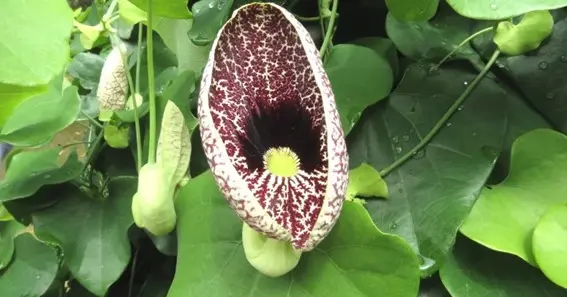What is Duck Flower? The Duck Flower is the biggest in the Hamanasi garden and others in Belize. This perennial vine fascinates botanists and nature lovers alike with its vast size and unique way of pollinating flowers. In this in-depth look, we dig into the delicate details of the duck flower, revealing its distinctive traits, ecological importance, and cultural links.
What Is Duck Flower?
The duck flower is a unique plant known for its unique qualities, whose formal name is Aristolochia. It is in the birthwort family and has big, round flowers that smell like dead meat. This smelly substance is crucial to its reproduction process because it attracts flies that act as unintentional breeders. Even though it doesn’t smell good, the duck flower is attractive because of its unusual look and way of being pollinated.
The duck flower, formally known as Aristolochia, is recognized for its large size, decaying meat-like smell, and fly-based pollination. Its odd look, quick development, and ecological importance make it a fascinating study and a significant ecosystem asset.
Proceed reading the article What is Duck Flower.
Also Read N: How Often Can You Take MiraLAX? Essential MiraLAX Knowledge
How Pollination Works In Duck Flower?

What makes duck flower’s mating method unique is that it shows how adaptable plants are in the wild. In contrast to most plants that depend on bees or butterflies for pollination, duck flowers have evolved to take advantage of the way flies hunt for food. The flower tricks Fly into thinking it might be food by giving off a strange smell that smells like rotten meat.
This clever system uses flies as unintentional pollinators to ensure plant reproduction. Although the smell may be unpleasant to humans, it is an important part of the complicated dance of pollination in nature. It shows how plants have changed to survive in their surroundings over millions of years.
So from the above post about what is Duck Flower reader must have got clear idea of this plant.
Also Read P: What Are The Questions To Ask Your Boyfriend And Its Significance?
Huge Size And Strange Appearance
The massive size of the duck flower makes it one of the most amazing flowers in the world. Compared to other flowers in the same plant family, the duck flower’s flowers are very tall. They usually measure several inches in diameter and stand out. This vast size sets duck flowers apart from other plants and adds to their beauty, drawing fans from far away.
The duck flower’s bright colours also make it more appealing. The purple and white shades mix beautifully to create a stunning show. These flowers stand out like gems against a background of lush green plants. In a way, the duck flower goes beyond what is usually considered beautiful. It shows us some of the fantastic things that happen in nature.
Quick Growth And Use As An Ornament
Fast growth and the ability to respond to different conditions make duck flowers popular in parks and landscapes worldwide. This makes it an excellent choice for many different settings. Because it grows quickly and vigorously, it can soon cover arbours, trellises, and fences with lush greenery, which enhances both protection and appearance.
Uses In Medicine And Cultural Significance
Traditional medicine systems have honoured duck flowers for their healing and medicinal qualities. People have used different parts of the plant, like its leaves, stems, and roots, to treat a wide range of health problems. Some countries use duck flowers to make tea or other drinks that can help with gut issues like gas, stomach cramps, and diarrhoea.
People with diseases like arthritis and rheumatism have also used its pain-relieving and anti-inflammatory qualities to feel better. Some communities use poultices or ointments made from duck flower extracts to neutralize snakebite venom and speed up the mending process. This use of the plant emphasizes its meaning as a sign of safety and strength in the face of hardship.
Here in the above paragraph, what is duck flower we know about its medical importance.
Effects On The Environment
The duck flower’s method of pollination not only helps it reproduce but is also an essential part of keeping the environment balanced. Because the flower smells so good, flies accidentally spread pollen from one plant to another. This helps genetic diversity and ensures that many plant species will survive. This process is critical for many plant groups to stay alive because it allows plants to produce seeds and grow new plants.
Conclusion
In conclusion, the duck flower is a beautiful example of nature’s creativity and variety. This fantastic plant continues to amaze and fascinate people with its vast size and unusual way of pollinating. Duck flower tells us how plants, animals, and the environment are all connected, whether it’s for their ornamental beauty, medical uses, or ecological importance. Whenever we think we know everything about the natural world, the duck flower makes us remember how much more there is to learn.
FAQ
Can You Eat Duck Flowers?
According to the FDA, duck flowers contain chemicals that could be harmful if eaten.
How Do Duck Flowers Get Flies To Come To Them?
Duck flowers smell bad, like rotten meat, which makes flies want to land on them. Fly attractants briefly trap the flies inside the flower, which helps with blooming.
Is It Possible To Grow Duck Flowers Inside?
It is possible to grow duck flowers indoors under certain conditions, but its fast growth and desire to spread may make it hard to do so in small areas.
Are There Any Environmental Issues That Come Up With Duck Flowers?
Wild animals and people taking too much of some kinds of duck flowers’ habitats may put them in danger. Conservation attempts are being made to keep these rare plants and their environments safe.
Is It Possible To Grow Duck Flowers From Cuttings?
If you take stem cuttings from a duck flower plant while growing, you can produce more buds. Make sure the stems have at least one root and cut off any leaves from the bottom before planting.
Sources:
https://www.hamanasi.com/belize/flowers-of-belize-flor-de-pato-duck-flower/










